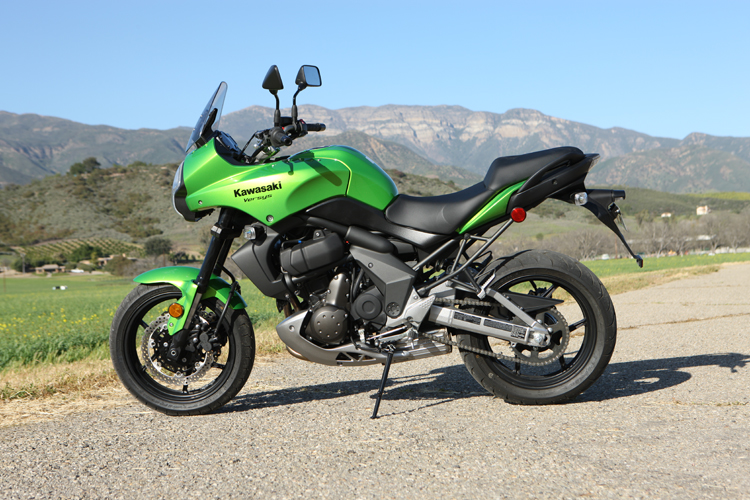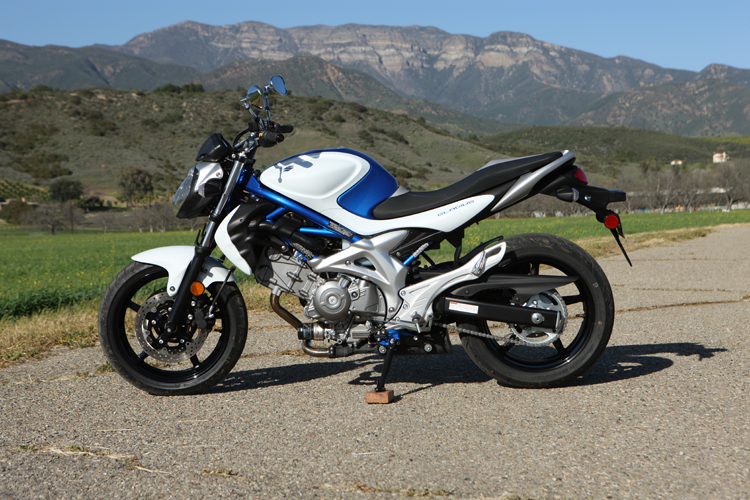2009 Kawasaki Versys & Suzuki Gladius
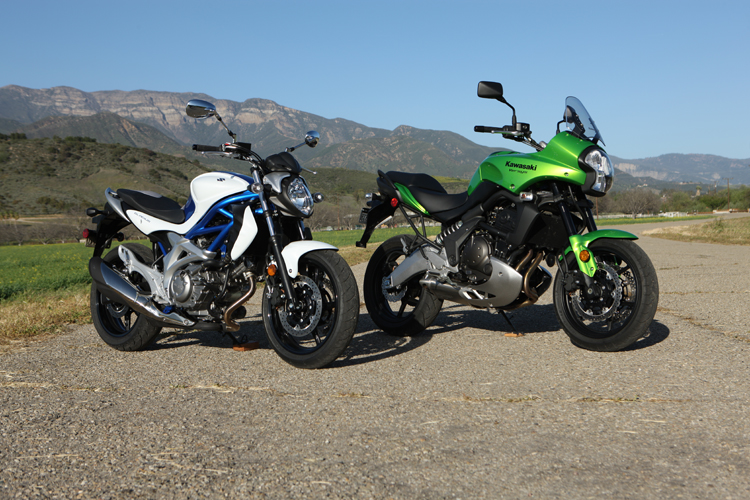
Up until the latest bubble burst, nearly everyone was extolling the virtues of behemoth motorcycles, often to the near exclusion of smaller machines. Back then, with some form of "size matters" splattered on nearly every bike magazine cover, it seemed like everybody was taking out equity loans on their houses and buying big, heavy, expensive large-displacement motorcycles.
So, perhaps one positive aspect of our economy tanking, if there is one, has been the newfound interest in smaller-displacement machines. Their light, nimble handling, ease of operation and great fuel economy can put a smile on your face - and leave some money in your bank account.
Ever since my first brief ride on a Versys last year (see "Kamp Kawasaki," Sept./Oct. 2008 issue), it has been on my short list of bikes to test. At the same time I got a 2009 Versys to try out, the new '09 Gladius (which essentially replaces the naked SV650 in the lineup) became available from Suzuki. So why not try out both 650 twins and compare their everyday performance?
The Gladius name derives from the swords used by Roman gladiators. The gladius was known as a compact, well-balanced sword and was employed extensively in combat. Kawasaki hasn't offered an explanation of how the Versys name was chosen, but it's obvious the bike is versatile - and Versys sounds better.
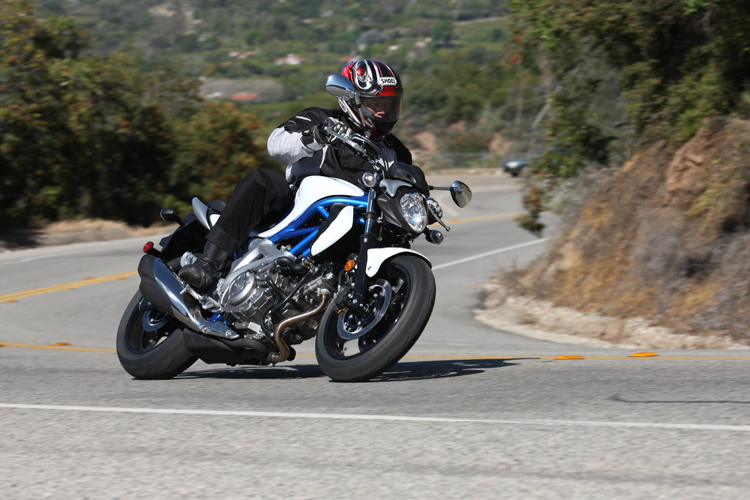
To create the Versys, Kawasaki engineers started with the Ninja 650R sportbike, using its parallel-twin engine, six-spoke wheels and basic chassis. To this they added an adjustable-height windscreen, longer-travel suspension bits, including the swingarm, rear shock, an inverted fork and a conventional handlebar. Kawasaki's Versys 650 was introduced in 2008 and is unchanged for 2009, except that its emission system is now legal in California, so it can be sold in my home state.
The Gladius is aimed more at new riders: it has a significantly lower seat, the footpegs are closer to the rider and the bike's center of gravity is also noticeably lower. Suzuki's marketing and the bike's styling also appear to be targeted at first-time buyers and a younger demographic than the Versys. The company is using hip, unconventional marketing for the Gladius, including a special website:www.gladiusstyle.com.
Drivetrain
A liquid-cooled, fuel-injected 90- degree V-twin engine with a dual-overhead camshaft layout and four valves per cylinder powers the Gladius. The 90-degree V-twin design is known for perfect primary balance for relatively smooth operation without the need for balance shafts. This powerplant, based on the popular SV650 series first introduced in 1999, has become something of a cult classic. However, Suzuki engineers modified this engine design for the Gladius to develop more power and torque at lower rpm, using twin-spark-plug heads, a 5-percent heavier crankshaft designed to smooth out low-speed operation, along with increased valve lift and other minor tweaks.
The result delivers a torque curve substantially higher than the SV650, without giving up any horsepower. Thumb the starter button and the Gladius pops to life instantly, cold or hot. It settles into a smooth idle quickly and has excellent drivability even when cold. The engine can lug down to 2,000 rpm in sixth gear, which is below 30 mph, and then pull away smoothly. Response is good overall, despite being slightly abrupt when going from closed to open throttle, mostly at low rpm. The surprisingly smooth, torquey V-twin produces a wide, useful power band along with a hearty exhaust note. There's no noticeable drop-off, right up to its 10,500 rpm redline.

The compact liquid-cooled, 649cc parallel-twin engine of the Versys is also a DOHC design with four valves per cylinder and fuel injection. It too was modified to deliver its torque slightly earlier than its Ninja 650R brethren, although a perusal of specifications shows it is down 3.6 lb-ft of maximum torque compared to the Ninja 650R. Parallel twins are not renowned for smoothness, but the 180-degree crankshaft plus balancer shaft are designed to reduce engine vibes to acceptable levels on this one.
Coolant is routed through the engine cases to reduce the number of external hoses, and oil jets on the connecting rod big ends spray oil under the pistons to aid internal cooling. Twin 38mm Keihin throttle bodies, with ECU-controlled sub-throttle valves (located behind the main throttle valves), are utilized to give the DFI system a more precise throttle response.
The Versys engine also starts easily, but tends to idle overly fast (around 2,000 rpm) for a while, which makes it difficult to ride off slowly, such as through a parking lot, until it warms up. It also protests if you lug it down below about 3,000 rpm, especially in high gear, where it doesn't smooth out until you're above 48 mph. From 3,000 revs on up it pulls nicely, it's comfortable running on the highway, and feels plenty peppy with power to spare, although its exhaust note is more muted than the Gladius.
Neither manufacturer provides horsepower figures, although we know it is in the vicinity of 70 for the Gladius and slightly lower for the Versys. Kawasaki rates maximum torque as 44.9 lb-ft at 6,800 rpm. We ran the two bikes against each other in acceleration tests, and the Gladius consistently won each round by a slight margin, even when riders were switched. However, the difference wasn't great, and both bikes feel lively and spirited. It was somewhat difficult to get a good consistent launch on the Versys, because it tends to wheelie easily, partly due to its higher and farther-back seating position. Both bikes deliver plenty of power for passing and highway riding, and vibration is never annoying on either one. That said, the Gladius engine is smoother, more powerful and revs more freely when ridden hard.

Both machines have a six-speed transmission and cable-actuated wet clutch. Lever pull is light and modulation easy on each bike. We found the Suzuki's gearbox to be almost flawless, with smooth, lightning-quick shifts and neutral easy to access. The Versys tranny feels easier to shift when cold and starts to get a "notchy," sticky feel to gearshifts as it gets hot; and neutral is harder to access as well. Nothing serious, but it's noticeable when comparing the two.
Frame & Chassis
The Gladius frame is a steel trellis, unlike the SV650's aluminum skeleton. It's partially obscured with plastic covers, which seem a bit over-stylized, but the chassis feels solid enough when riding. Similarly, the Versys employs a tubular steel semi-double cradle frame, which also feels sufficiently stiff.
Up front, the Versys has a long-travel, 41mm inverted fork, which reduces road shocks and jolts, and delivers a nice balance of plushness without diving excessively under braking. Rake is 25.0 degrees, and trail is 109mm, for quick steering. Its rear suspension is damped by an offset-mounted Showa single rear shock, similar in layout to the Ninja 650R. Utilizing two-stage valving for progressive compression damping, the rate increases significantly as the shock moves through its stroke. This allows an initial feel that is soft, but it firms almost to sportbike levels as the suspension compresses more. A longer-than-average aluminum swingarm reduces unsprung weight and allows more travel.
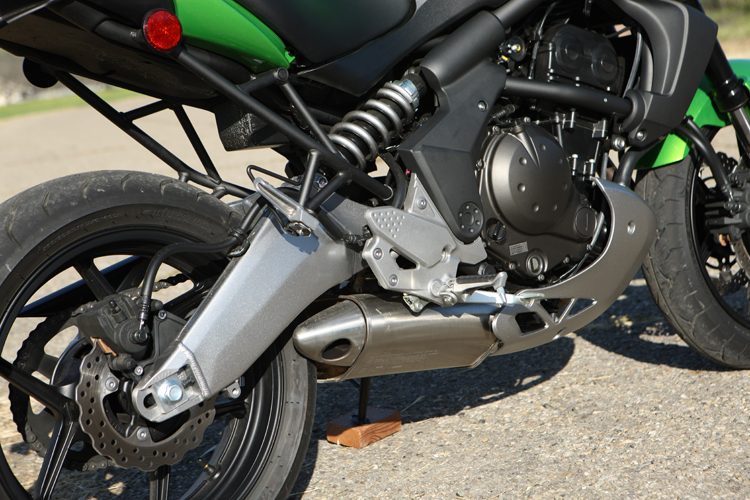
Suzuki fits a conventional 41mm fork similar to the SV650's unit on the Gladius, only with slightly shortened stroke. Rake stays at 25.0 degrees, while trail increased compared to the SV650, up 4mm to 106mm - still very sporty. In back, a steel swingarm is controlled by a single shock. On the road, the Versys has a plusher ride that soaks up rough pavement. The Gladius feels noticeably stiffer over bumps, but when it comes time to ride the bike fast, firm suspension is a good thing. Still, both bikes could use better suspension components and more adjustability.
Brakes, Tires, Handling
Both bikes come with dual front rotors clamped by two-piston sliding-pin calipers in front and a single-pot caliper and disc in back. These budget-priced components provide ample braking for most riders in most situations, but there's room for more bite and stopping power that comes with four-piston calipers. We also noticed that the brake pedal on the Versys requires an excessive amount of travel all the time and is hard to modulate during a fast, hard stop.
You'll find 120/70ZR17 rubber on the front and 160/60ZR17 hoops on the back of both bikes. Dunlop Qualifier J tires are original fitment on the Suzuki, while Dunlop's Sportmax D221 is standard on the Kawi. Both types perform satisfactorily with good overall grip, and they feel stable and don't chase longitudinal pavement seams or rain grooves. However, the Qualifier J tires seem to be more sensitive to tar snakes and painted lines, etc., on the road - and they gave me a thrill a few times when crossing these while leaned over.

Each bike offers a good balance of agility and security, combining quick, light steering with confidence-inspiring stability. With a competent rider, either motorcycle can hustle through the twisties like a sportbike, yet both are docile enough to be handled by newbies. At high speeds, the Versys feels more composed and stable; while the Gladius is at its best on a tight, twisty canyon road.
Features & Ergonomics
The bikes have an upright riding position with footpegs directly below the rider and conventional one-piece handlebars. The Versys favors taller riders and this bike fit me (6' 1") very well thanks to its larger, flatter and thicker saddle, wider handlebar and more distance to the pegs. By comparison, the Gladius felt cramped and its thinly padded saddle, designed to reduce seat height, also reduces comfort. Adding to my discomfort, a forward-sloping seat forces the rider forward against the gas tank, and the footpegs are closer to the seat. However, shorter folks will appreciate its reach to the ground, and the shape of the saddle makes it easier to plant your feet in close to the bike when stopped. A 20mm taller saddle is available from Suzuki as an accessory, and this may help accommodate taller riders on the Gladius.
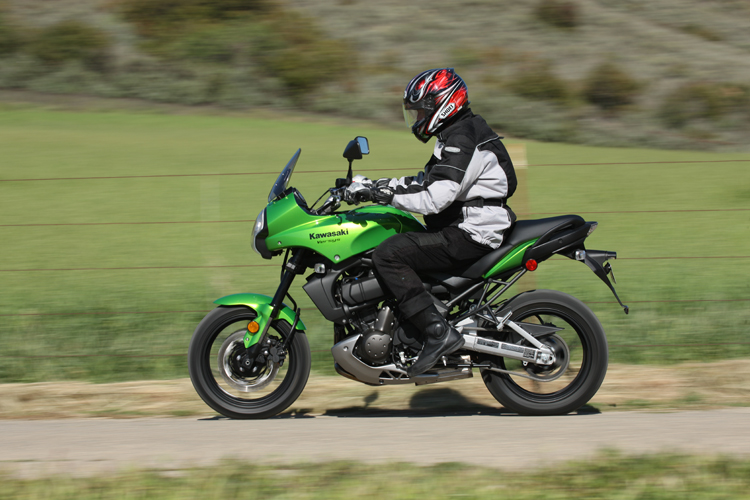
Each machine has useful, wide-set mirrors that don't shake noticeably from vibration, and have functional grab handles for passengers. However, pillion riders complained of the forward-sloping seat on the Kawi and the thin, tapered pad on the 'Zuki. Neither bike is designed for long-haul passengers.
One of the top features on the Versys for rider comfort is the adjustable windscreen that can be manually moved to three positions in 20mm increments by removing four fasteners. Although the screen is not large, it effectively reduces the wind's force on the rider without buffeting. The Gladius comes without windscreen, and the rider gets a constant windblast at highway velocities. An accessory fly-screen is available.
Both bikes have analog tachometers with redlines conveniently located at the top, and digital speedometers, along with the usual complement of indicator lights. The Versys instrument panel includes a horizontal bar-graph fuel gauge and a clock function, along with dual tripmeters. The Gladius has dual tripmeters, plus a gear indicator, a clock and fuel-reserve tripmeter, but no fuel gauge. When the fuel mark starts blinking, the reserve tripmeter shows the distance from fuel-reserve indicator activation until the tank is refilled. It then resets automatically when filled.

There's not a lot of room on either bike for carrying a large tailbag, as the pillion pads are narrow and you have to be creative to find tie-down points other than the grab handles at the rear. Also, the plastic side panels on the Gladius tank render magnetic tank bags ineffective. However, the low-mounted mufflers on both bikes make it easy to throw on a pair of soft saddlebags.
Fuel economy was fairly consistent in the upper 40s, with the Gladius averaging 45.6 and the Versys averaging 47.7 mpg overall. There's a very significant difference in fuel capacities, though, with the Versys carrying 5.0 gallons, and the Gladius holding only 3.8-gallons (3.6-gal. California) in its tank. Typically, the Versys could reach about 200 miles before indicating low fuel, but the Gladius could only make about 125 miles before tapping its reserve.
Parting Thoughts
Both bikes are a blast to ride, get excellent fuel mileage and boast numerous strong points. They exhibit good quality, fit and finish, and were trouble-free in testing. The Gladius has a great engine and gearbox, light, quick, nimble handling, accommodates shorter riders and should be a favorite among this group - along with newcomers to the sport. The Versys is likely to appeal to taller and more experienced riders, and its longer-travel suspension, larger fuel tank, wind protection and more comfortable seat should make it attractive to adventure-touring aficionados.
For those who like the Gladius (or its engine), but perhaps find it a tad small, there's always the V-Strom 650 or the sportier SV650SF. If you prefer a Kawasaki, but find the Versys too tall, Kawi's ER-6N may be the one for you.
Technical Specs
+ great engine and gearbox, nimble handling, low seat height
- no wind protection, feels cramped for larger riders, thin hard seat
Distributor American Suzuki www.suzuki.com
MSRP $ 6,899
Engine 90° V-twin, DOHC, 4-valve per cylinder
Displacement 645cc
Bore x Stroke 81x62.6mm
Fuel System digital fuel injection w/39mm throttle bodies
Power n/a
Cooling liquid w/thermostatic fan
Ignition digital electronic
Transmission 6-speed
Frame steel-tube trellis
Front Suspension 41mm conventional fork, adjustable for preload, with 4.9in travel
Rear Suspension steel double-sided swingarm, single shock adjustable for preload, 5.1in travel
Rake/Trail 25°/4.17in (106mm)
Brakes Front/Rear twin 290mm discs, 2-piston sliding calipers/ one 240mm disc, 1-piston sliding caliper
Tires Front/Rear 120/70ZR17/ 160/60ZR17
Curb Weight 445lbs (448 Calif.)
Wheelbase 56.9in (1445mm)
Seat Height 30.9in
Fuel Capacity 3.8gal; Calif. 3.6gal
Fuel Consumption 45.6mpg avg
Colors Metallic Blue/White; Candy Ruby Magenta/White; Pearl Nebular Black/Metallic Green; Pearl Nebular Black
TECHNICAL SPECS
+ great overall performance, balance of handling and comfort, long range
- too tall for some riders, slightly less-spirited engine, gearbox notchier
Distributor Kawasaki Motors Corp., USA
MSRP $ 7,099
Engine DOHC, 4-valve per cylinder, parallel twin
Displacement 649cc
Bore x Stroke 83x60mm
Fuel System digital fuel injection with two 38mm Keihin throttle bodies
Power hp n/a, maximum torque 44.9lb-ft @6,800rpm
Cooling liquid w/ thermostatic fan
Ignition digital electronic
Transmission 6-speed
Frame steel semi-double cradle
Front Suspension 41mm inverted hydraulic fork with adjustable rebound and preload, 5.9in travel
Rear Suspension aluminum swingarm, single offset shock with adjustable rebound and spring preload, 5.7in travel
Rake/Trail 25°/4.3in (109mm)
Brakes Front/Rear dual 300mm petal discs with 2-piston sliding calipers/ single 220mm petal disc with single-piston caliper
Tires Front/Rear 120/70-17/ 160/60-17
Curb Weight 454.1lbs
Wheelbase 55.7in
Seat Height 33.1in
Fuel Capacity 5.0gal
Fuel Consumption 47.7mpg avg
Colors Candy Plasma Blue, Candy Lime Green





